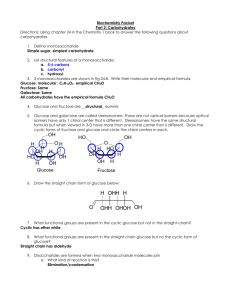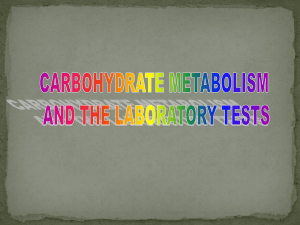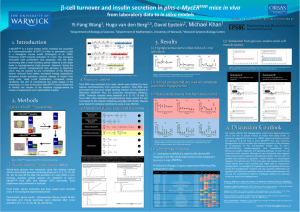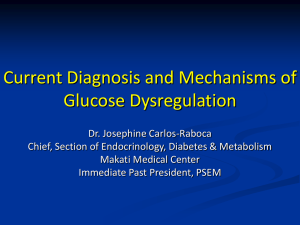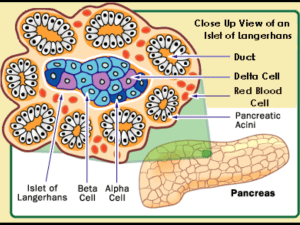2-Presentations\Toffolo
advertisement
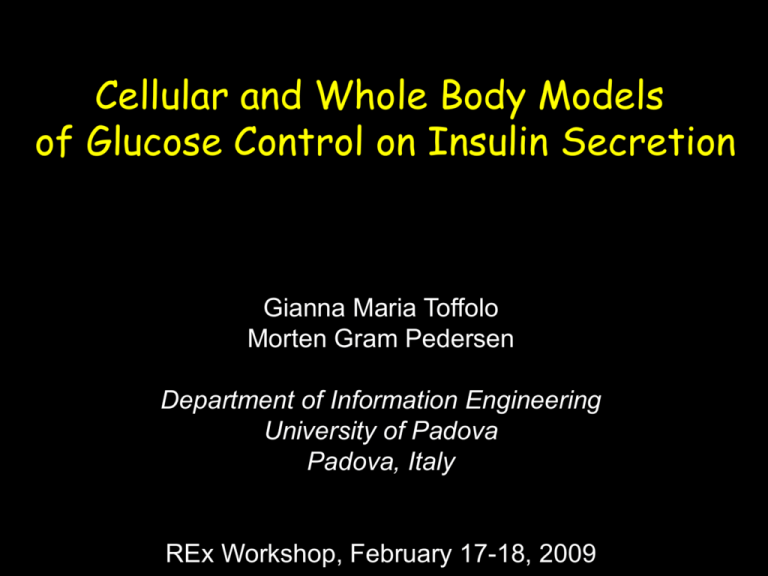
Cellular and Whole Body Models of Glucose Control on Insulin Secretion Gianna Maria Toffolo Morten Gram Pedersen Department of Information Engineering University of Padova Padova, Italy REx Workshop, February 17-18, 2009 Whole Body Models Models to measure • Simple models, with a few parameters to be identified on data of an individual • Measure glucose control on insulin secretion • Usable in clinical practice • Based on plasma measurements (C-peptide and glucose) during a minimally invasive protocol From i.v. and oral tests Cellular Models Models to understand IVGTT: Young vs Elderly Subjects N = 59 vs 145 (Dr. Rizza & Basu, Mayo Clinic) [mg/dl] 350 GLUCOSE 250 Elderly 150 Young 50 0 0 60 [pmol/l] 900 120 180 t [min] 240 INSULIN 700 500 300 100 0 t [min] 0 60 [pmol/l] 2000 120 180 240 C-PEPTIDE 1600 1200 800 400 0 t [min] 0 60 120 180 240 IVGTT:C-peptide Minimal Model (Toffolo et al, 1995) CP1(t)= - (k01 + k21) = CP +m k12X(t) CP2(t) + SR(t) SR(t) SR 1(t) b + CP2(t)= k21 CP1(t) - k12 CP2(t) SRb X(0)=X0 X(t) = - m X(t) + Y(t) Basal Responsivity Φb= Gb X0 1 Φ1= Y(t) = 1st Phase [Y(t)Responsivity – Φ2 (G-h)] Glucose G ΔG T SECRETION Delay Delay Y k21 2nd Phase Releasable Insulin m k12 1st Phase k01 Glucose ΔG CP2 CP1 X Rate of Increase of 2nd Phase Responsivity [pmol/min] IVGTT: Insulin Secretion Phases 4000 ISR 3000 2000 1000 t [min] 0 -30 0 4000 BASAL 150 1st 3000 120 180 240 1000 PHASE 2000 500 50 1000 250 0 -30 0 0 0 60 120 t [min] 180 240 2nd PHASE 750 100 -30 Φb: Basal ISR / Basal G 0 60 120 t [min] 180 240 -30 0 60 120 t [min] 180 240 Φ2: Over Basal Φ1: 1st Phase ISR / DG 2nd Phase ISR/ Over Basal G T: Delay between 2nd Phase ISR and G 400 [mg/dl] [pmol/min] 200 60 Glucose 300 200 100 0 -30 t [min] 0 60 120 180 240 IVGTT: β-Cell Responsivity Indices N=59Y vs 145E Φ1 Φb 250 [10-9] [10-9 min-1] 8 6 4 2 50 0 0 Y * 150 E Y E * p<0.05 Φ2 T 20 * 15 10 [min] [10-9 min-1] 15 10 5 5 0 0 Y E Y E From IVGTT to more physiological protocols (OGTT or meal) Meal: Young vs Elderly Subjects N = 59 vs 145 (Dr. Rizza & Basu, Mayo Clinic) GLUCOSE [mg/dl] 200 160 Elderly 120 Young t [min] 80 0 240 360 420 INSULIN 500 [pmol/l] 120 300 100 t [min] 0 [pmol/l] 3000 120 240 360 420 C-PEPTIDE 2000 1000 t [min] Meal: C-peptide Minimal Model (Toffolo et al, 2001; Breda et al, 2001, 2002) Glucose SR(t) = SRb + SRd(t) + SRs(t) CP1(t)= - (k01 + k21) CP1(t)SR + k12CP2(t) + SR(t) b phase SR Static dGs = Y BasalkDynamic Responsivity = (t) bCP CP2(t)= - kΦ Phase 1d 21 CP1(t) 12SR 2(t)= Φ dG b dt – Φ2 (G-h)] Y(t) = [Y(t) Dynamic T Responsivity SECRETION Static Responsivity Delay Delay k21 Static Phase CP1 CP2 k12 Dynamic Phase k01 Rate of Increase of Glucose (first 50-60 minutes) [pmol/min] Meal: Insulin Secretion Phases 4000 ISR 3000 2000 1000 t [min] 0 -30 0 BASAL 150 4000 100 3000 50 2000 0 -30 120 180 240 1000 0 60 120 t [min] 180 240 500 250 0 0 -30 -30 Φb: Basal ISR / Basal G STATIC 750 DYNAMIC 1000 0 60 120 t [min] 180 240 Increase 0 60 120 t [min] T: Delay between Static ISR and 400 300 GLUCOSE 100 0 240 static ISR / over basal G G 200 180 Φs: over basal Φd: Dynamic ISR / Glucose Rate of [mg/dl] [pmol/min] 200 60 t [min] Meal: β-Cell Responsivity Indices N=59Y vs 145E 8 800 6 600 [10-9] [10-9 min-1] Φb 4 * 400 2 200 0 0 Y Φd E Y E * p<0.05 Φs 20 30 [min] [10-9 min-1] 40 T 20 15 10 10 5 0 0 Y E * Y E To quantify the efficiency of the glucose-insulin regulatory system….. BRAIN PRODUCTION LIVER - GLUCOSE UTILIZATION + MUSCLE Insulin Sensitivity β-CELLS + SECRETION TISSUES INSULIN B-cell Responsivity DEGRADATION LIVER • Measurement of insulin secretion alone provides limited insight • It is important to determine whether b-cell secretion is appropriate for the degree of insulin resistance Glucose Minimal Model IVGTT MEAL (Dalla Man & Cobelli, 2002) (Bergman & Cobelli, 1979) OGTT/MEAL Gastrointestinal Tract IVGTT k5 k1 GLUCOSE LIVER k5 k1 TISSUES GLUCOSE LIVER TISSUES k4 SI k6 PLASMA INSULIN SI k6 k2 REMOTE INSULIN REMOTE INSULIN INSULIN k2 k3 k4 k3 12 59 Y vs 145 E * 8 4 0 Y E * p<0.05 [10-4 dl/kg/min per mU/ml] [10-4 dl/kg/min per mU/ml] Insulin Sensitivity 20 * 15 10 5 0 Y E Efficiency of the Control: Disposition Index (Bergman & Cobelli, 1981, Cobelli et at, 2007) Beta-Cell Responsivity Insulin Sensitivity x Beta-Cell Function= Constant Increased II Normal 2 I Normal Tolerance Impaired Tolerance Reduced Normal Insulin Sensitivity IVGTT Disposition Indices 59 Y vs 145 E [10-14 dl/kg/min per pmol/l] [10-14 dl/kg/min per pmol/l] DI1 3000 * 2000 1000 0 E DI2 [10-14 dl/kg/min2per pmol/l] [10-14 dl/kg/min2 per pmol/l] Y 160 * 120 80 40 0 Y Meal E * p<0.05 DId 20000 15000 * 10000 5000 0 Y E DIs 1200 * 800 400 0 Y E Use in Pathophysiology Role of age and gender (Basu et al, Diabetes 2006) Pathogenesis of Prediabetes (Bock et al, Diabetes 2006) Role of Race (Petersen et al, Proceedings of the National Academy of Science 2006) Efficiency of Anti-aging Drugs (Nair et al, New England Journal of Medicine 2006) Type 2 Diabetes ( Basu et al, Diabetes Care, 2009) Children and Adolescent (Sunehag et al, Obesity 2008) Diurnal Variation of Glucose Tolerance (Dr. E. Van Cauter, University of Chicago, Chicago, IL) Reduced OGTT & Meal Protocols (Dalla Man et al, Diabetes ,2006) Whole body models vs cellular events Glucose Delay k21 Static Phase CP1 CP2 k12 Dynamic Phase k01 Rate of Increase of Glucose Mechanistic intepretation of minimal model parameters Cellular Model Dynamics of β-Cell Turnover in Rats (Manesso et al, EASD 2008) Pancreatic islet - himmunohystochemistry Replication Rate (RR) (Dr P.Butler, UCLA) Other Sources of β-Cells (OSB) β-Cell Mass M ? Apoptosis Rate (RA) OSB [mg/month] dM = RR – RA + OSB dt 16 8 0 0 5 age [month] 10 Thanks CLAUDIO COBELLI ROBERT RIZZA Elena Breda Rita Basu Marco Campioni Ananda Basu Chiara Dalla Man F. John Service Erica Manesso (Rochester, MN) Paolo Denti (Padua, Italy) PETER BUTLER (UCLA, Los Angeles) Andrea Caumo (Milan, Italy) Whole body models vs cellular events Glucose Delay k21 Static Phase CP1 CP2 k12 Dynamic Phase k01 Rate of Increase of Glucose Mechanistic intepretation of minimal model parameters Cellular Model Model Assessment Insulin Secretion: Model vs Deconvolution Insulin Secretion [pmol/min] 1600 Deconvolution 1200 800 C-Peptide Minimal Model 400 t [min] 0 0 100 200 300 Need of All the MM Ingredients e.g. Dynamic Glucose Control [pmol/min] 1600 Insulin Secretion Deconvolution 1200 Model without Φd 800 C-Peptide Minimal Model 400 t [min] 0 0 100 200 300 MM Indices vs HGC Counterparts IVGTT vs Hyperglycemic Clamp 1st Phase β-cell Responsivity Meal vs Hyperglycemic Clamp Static β-cell Responsivity Φ1IVGTT (103 pmol/l/min) (nmol/min per mmol/l) Φsmeal (103 pmol/l/min) Φ1HGC (Steil et al, 2004) ΦsHGC (pmol/min per mmol/l) Φ1: Correlation with Other Indexes N=204 R=0.72, p<0.001 10000 Φ1 (10-9) 8000 6000 4000 2000 0 0 100 200 300 AIR (pmol/l∙ min) 400 500 600 MM Indices vs AV Measurements VALIDATION PROBLEMS 1. Simple net balance equations are not appropriate out of steady state 2. The transit time of the substance needs to be explicitly considered C-peptide AV Model CPA: C-peptide Femoral Artery Glucose Glucose Increase Φs Φd Delay SR g(t) F CPV: C-peptide Hepatic Vein Distribution of C-peptide intransit times from Femoral femoral artery to hepatic vein Artery Secretion t CPV(t) = CPA(s)+ SR(s) g(t - s) ds F 0 C-peptide in Hepatic Vein Blood Flow Meal vs AV (N=12) 1000 [pmol min-1] 750 Insulin Secretion 500 Meal AV 250 0 0 60 120 180 300 240 360 Time [min] Φs Φd 3000 0 100 0 [l 109] 0 [l 109 min-1] 200 1500 0 Meal AV Meal AV Protocols, Attributes and Information Content Is it Simple? Is it Physiological? BASAL STATE Can Assess Insulin Sensitivity? Can Assess Beta-Cell Function? Yes Yes Yes, but limited Hyperglycemic Clamp No No Yes, but requires a model Euglycemic Clamp No No Yes IVGTT No No Yes, but limited without a model Yes, but limited without a model Yes, but no nutrients Yes Yes, but requires a model Yes, but limited without a model Yes Yes Yes, but requires a model Yes, but limited without a model Yes, but limited INTRAVENOUS PERTURBATION Yes, but limited without a model No ORAL PERTURBATION OGTT Meal Reproducibility: IVGTT β - Cell Responsivity Φ2 Φ1 ∆ = 4% ∆ = 17% [10-9 min-1] 25 250 15 5 50 0 0 Day A Day B Day A Insulin Sensitivity [10-4 dl/kg/min per mU/ml] [10-9] 500 8 SI ∆ = 12% 6 4 2 0 Day A Day B Day B Reproducibility: Meal β - Cell Responsivity [10-9 min-1] 1200 600 0 Φs 60 ∆ = 1% ∆ = 7% 40 20 0 Day A Day B Day A Insulin Sensitivity [10-4 dl/kg/min per mU/ml] [10-9] 1800 Φd 16 SI ∆ = 7% 12 8 4 0 Day A Day B Day B b-cell Function: IVGTT vs Meal IVGTT vs Meal: β-Cell Responsivity N=204 Φ1 Φd + 251% * 800 600 Φ2 + 253% * 40 30 400 20 200 10 0 0 IVGTT Φs Meal IVGTT Meal • Incretin hormones? • Differences in the pattern of glucose stimulus? • Effect of fat/protein in the meal? IV vs Oral Glucose: Assessment of Incretin Effect N=10 (Dr. Rizza & Service, Mayo Clinic) GLUCOSE [mg/dl] 180 IV-OGTT 140 OGTT 100 80 -30 0 120 180 240 180 240 t [min] INSULIN 50 [uU/ml] 60 30 10 -30 0 120 t [min] C-PEPTIDE 6 [ng/ml] 60 4 2 t [min] -30 0 60 120 180 240 Dynamic Secretion Static Secretion p<0.05 400 [pmol/min] 300 OGTT I-IVG 200 100 200 0 0 0 0 60 120 180 240 60 120 180 -200 t [min] t [min] 30 Φs + 55% * 600 [10-9] [10-9 min-1] [pmol/min] 400 20 10 Φd + 68% * 400 200 IV-OGTT OGTT * p<0.05 IV-OGTT OGTT 240 Reduced Oral Protocols OGTT (N=100) REDUCED 120 min – 7 Samples 0 10 20 30 60 120 90 Φd 0 full red 1500 00 1500 full 3000 red red 600 120 60 R=0.98, p<0.0001 (10-9 min-1) 3000 1200 (10-9 ) Φs 30 0 full red R=0.88, p<0.0001 60 0 0 60 full 120 Hepatic Insulin Extraction Rationale C-PEPTIDE ISR LIVER k2,1 CP1 CP2 k1,2 k0,1 ISR b-CELLS INSULIN IDR I LIVER n ISR - IDR HEPATIC EXTRACTION = ISR Estimation of Hepatic Insulin Extraction (Toffolo et al, 2006) C-peptide Model IM-IVGTT 350 Glucose 200 Delay Glucose 0 0 60 120 180 240 Releasable C-peptide Glucose Increase MEAL KINETICS SECRETION ISR Glucose k21 CP1 k12 CP2 80 k01 900 0 500 60 120 180 240 300 360 420 Insulin Insulin Insulin Model 0 SECRETION 0 60 120 180 Delay Glucose C-peptide Glucose Increase 0 0 60 120 180 0 0 240 2000 KINETICS Releasable Insulin IDR 60 120 180 240 300 360 420 VI 3000 C-peptide I n 240 Insulin Bolus time [min] 0 0 60 120 180 240 300 360 420 time [min] HEPATIC EXTRACTION = ISR - IDR ISR Population Model (Van Cauter, 1991) From Insulin Bolus C-peptide Kinetics Population Model Insulin Kinetics Population Model (Van Cauter, 1992) IVGTT: Hepatic Extraction N=59Y vs 145E Profile 1 ELDERLY 0.8 ISR(t) - IDR(t) (%) HE(t) = ISR(t) 0.6 0.4 YOUNG 0.2 0 0 60 120 t [min] 180 Index 1.00 T HE = 0.80 ISR(t)dt – IDR(t)dt 0 0 0 T ISR(t)dt (%) T * 0.60 0.40 0.20 0.00 * p<0.05 Y E 240 Meal: Hepatic Extraction N=59Y vs 145E Profile 1.00 ELDERLY (%) 0.80 0.60 0.40 0.20 YOUNG 0.00 0 60 120 180 240 300 360 420 t [min] Index 1.00 (%) 0.80 0.60 * * p<0.05 0.40 0.20 0.00 Y E Disposition index Open Questions • Does the hyperbolic relation DI=Φ x SI hold in a population or is it DI=Φ x SIα? • Average individual DI or value estimated in the population? • Linear regression on log-trasformed variables or nonlinear regression on original variables? • Ordinary regression with errors in one variable or regression with errors in two variables? Φ1 [10-9] Does Average Linear Regression theregression hyperbolic individual with error on DI relation Disposition log-trasnformed orinvalue one DI= variable estimated Φ Index x SIvariables or in in a population the twoor population? variables? nonlinear or is it regressionDI= on original Φ x Siα?variables? Averaging XY Averaging XY fit fit 0.68=330 xxSISI=732 Φ xx SI 0.68=330 Φ SI=732 ΦΦ logXY Y fit fit XY 0.68= 0.77 330 ΦΦ SI Φxx xSI SI0.19=578 =135 SIivgtt [10-5 min-1 per pmol/l] From 2D to 3D? 1-HE [dimensionless] The classical DI ignores the effect of hepatic insulin extraction Φ1 [10-9] SIivgtt [10-5 min-1 per pmol/l] From IVGTT to slower profiles Glucose SECRETION Y Delay 2nd Phase Releasable Insulin 1st Phase m k21 CP1 X k12 CP2 k01 Rate of Increase of Glucose ΔG • Since m is rapid (1/m=1-2 minutes) with respect to the slower (than IVGTT) time course of insulin and glucose concentration, m cannot be resolved from the data. • 1st phase dynamic phase (related to dG/dt, active during the glucose rising phase) • 2nd phase static phase (related to G) Meal: Non Diabetics vs Type 2 Diabetics N=14 vs 11 (Dr. A. Basu) [mg/dl] GLUCOSE 400 Diabetics 200 t [min] Non Diabetics 0 240 360 INSULIN 120 [uU/ml] 120 80 40 t [min] 0 240 360 C-PEPTIDE 5000 [pmol/l] 120 3000 1000 t [min] 0 120 240 360 β-Cell Responsivity Indices N=14 vs 11 Φb 4 400 0 * 0 ND D ND Φs 60 D T 140 * 100 40 * [min] [10-9 min-1] Φd * p<0.05 [10-9] [10-9 min-1] 8 800 60 20 20 0 ND D ND D Type 2 Diabetes: Effect of Pioglitazone (Basu A. et al submitted) Glucose Pre-pio Post-pio Nondiabetic 25 Insulin C-peptide Pre-pio Post-pio Nondiabetic 140 120 5.000 20 Pre-pio Post-pio Nondiabetic 4.000 15 nmol/L uU/ml mM 100 80 3.000 60 10 2.000 40 5 1.000 20 0 0 0 60 120 180 240 300 -60 360 0.000 0 60 30 15 240 300 360 -60 pre pio post pio Nondiabetic 700 600 60 50 40 400 300 30 20 10 200 5 0 60 10 100 0 0 * p<0.05 pre vs post treatment ^ p<0.05 post treatment vs nondiabetic 120 180 s pre pio post pio Nondiabetic 500 * 0 time (min) 800 10^-9 10^-5 dl/kg/min per pmol/L 20 180 d SI 25 120 time (min) Time (min) 10^-9 min^-1 -60 pre pio post pio Nondiabetic 240 300 360 Children and Adolescents NGT_NFG NGT_IFG IGT_NFG (Dr. Caprio) INSULIN GLUCOSE 450 160 400 140 350 120 300 100 250 C-PEPTIDE 7000 6000 5000 pmol/l uU/ml 180 200 80 60 150 40 100 20 50 0 60 90 120 150 180 1000 0 0 30 min 5 4 3 3000 NGT_IFG * * * ^ IGT_NFG IGT_IFG 2500 2000 10-9 6 90 120 150 180 0 30 60 * * ^ 1500 Φs 90 * 75 45 30 500 15 0 * p<0.05 vs NGT-NFG; ^ p<0.05 vs NGT-IFG; # p<0.05 vs IGT-NFG * # 60 1000 1 120 min 2 0 90 Φd NGT_NFG 7 60 min SI 8 3000 10-9 min-1 30 4000 2000 0 0 10-4 dl/kg/min per uU/ml mg/dl IGT_IFG 0 150 180 Whole Body Models • Provide estimates of beta cell function in an individual • Based on plasma measurements (Cpeptide and glucose) during a minimally invasive protocol INSULIN SYSTEM Secretion+Kinetics PLASMA C-peptide PLASMA GLUCOSE • Usable in clinical practice From i.v. to oral tests PLASMA INSULIN GLUCOSE SYSTEM
